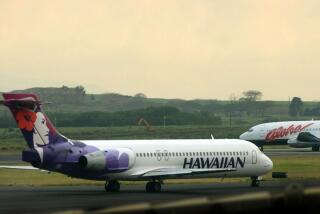As its peers pair off, Alaska Airlines follows its own path
- Share via
Reporting from Seattle — Alaska Airlines Chief Executive Bill Ayer pilots a rarity in the airline industry — a carrier that has made it through a turbulent decade without filing for bankruptcy or merging with another airline.
He plans to keep it that way, despite speculation that the Seattle airline is too small to operate alone.
“The history of mergers in this industry is not a good one,” said Ayer, Alaska’s CEO since 2002 and CEO of Alaska Air Group Inc. “There have been rumors about somebody buying Alaska Airlines as long as I’ve been here, and probably longer than that.”
Indeed, airline mergers have become a hallmark of U.S. economic downturns.
The companies that ferry us through the air for hundreds of dollars a pop have an extraordinarily difficult time making money.
Any instability — fewer fliers, higher oil prices — and the result is a series of shotgun weddings.
In the latest recession, United Airlines hooked up with Continental Airlines, Delta Air Lines merged with Northwest Airlines and earlier this month Southwest Airlines completed its purchase of AirTran Airways.
That trend leads some investors to believe that Alaska will merge eventually. But strong profits and a high stock price keep the Seattle-based airline independent for now.
Alaska made money in the first three months of this year, when many airlines were bleeding because of the higher fuel costs.
Its shares trade so dearly that Alaska’s worth based on its stock price is nearly $2.5 billion, almost $1 billion more than US Airways, whose revenue is triple Alaska’s.
“Alaska continues to sit in the catbird seat, given its attractive West Coast niche,” analyst Daniel McKenzie of Hudson Securities wrote in a recent research report.
Alaska’s financial muscle “leaves management in the enviable position of being able to call the shots.”
That does not keep McKenzie and other Wall Street analysts who know the airline industry well from speculating about future mergers.
Southwest’s acquisition of AirTran “ultimately forces Alaska to become part of a bigger airline,” he wrote.
The reasoning: The smallish carrier will face challenges competing with the low prices, stronger network and more powerful balance sheet of a super-sized Southwest.
US Airways certainly feels a threat from airline consolidation and is practically begging for a partner.
“There is one big deal left, and that’s with US Airways,” CEO Doug Parker said last month.
But it does not consider Alaska a good fit, said Scott Kirby, president of Tempe, Ariz.-based US Airways.
The only outcome of that merger would be to “take a cost structure that’s profitable [Alaska’s] and make it unprofitable,” Kirby said at the Phoenix International Aviation Symposium in April.
Other airlines are not courting Alaska either, partly because they know Ayer has no interest.
The airline’s lock on the state of Alaska is lucrative but not a huge draw for tourists.
“They’ve got our 49th state sewn up, but except for [Sarah] Palin, it’s not a top-10 destination,” said Tom Parsons, CEO of discount travel site Bestfares.com.
Alaska also maintains a pleasant demeanor in the skies, not threatening competitors with its fares or routes.
It did not make a big move into Hawaii until after the demise of Aloha Airlines and ATA Airlines left a vacuum there.
“We think of them like Switzerland in terms of being neutral,” said Helane Becker, an analyst at Dahlman Rose & Co. in New York.
Still, in the next downturn she expects midsize carriers such as Alaska to merge, and named American Airlines, Delta and Hawaiian Airlines as possible partners for it.
Alaska and American fly a lot of 737s and have a business relationship that allows them to sell tickets on each other’s flights.
Alaska also has that relationship with Delta, and might merge with another midsize carrier such as Hawaiian, Becker said.
Ayer brushes off the conjecture and keeps setting an independent agenda for Alaska.
Growth is key to Alaska’s future, but a merger isn’t necessary to achieve it, Ayer said.
The airline does not even need to add whole new regions or countries to reach the 3% to 6% growth promised to Wall Street, he said.
“Adding three to six long-haul trips a year would give us 3 to 6% growth,” Ayer said. “And we have just one or two flights a day in a lot of markets.”
Despite its financial chops, Alaska remains a midsize carrier, and a merger with another airline its size makes the most sense, said aviation consultant Scott Hamilton of Leeham Co.
He named JetBlue Airways, Frontier Airlines and Spirit Airlines as possible partners.
And in another bit of conjecture for Ayer to ignore, Hamilton said: “Somebody might come in and try to acquire them. You just never know.”
Allison writes for the Seattle Times/McClatchy.
More to Read
Inside the business of entertainment
The Wide Shot brings you news, analysis and insights on everything from streaming wars to production — and what it all means for the future.
You may occasionally receive promotional content from the Los Angeles Times.










